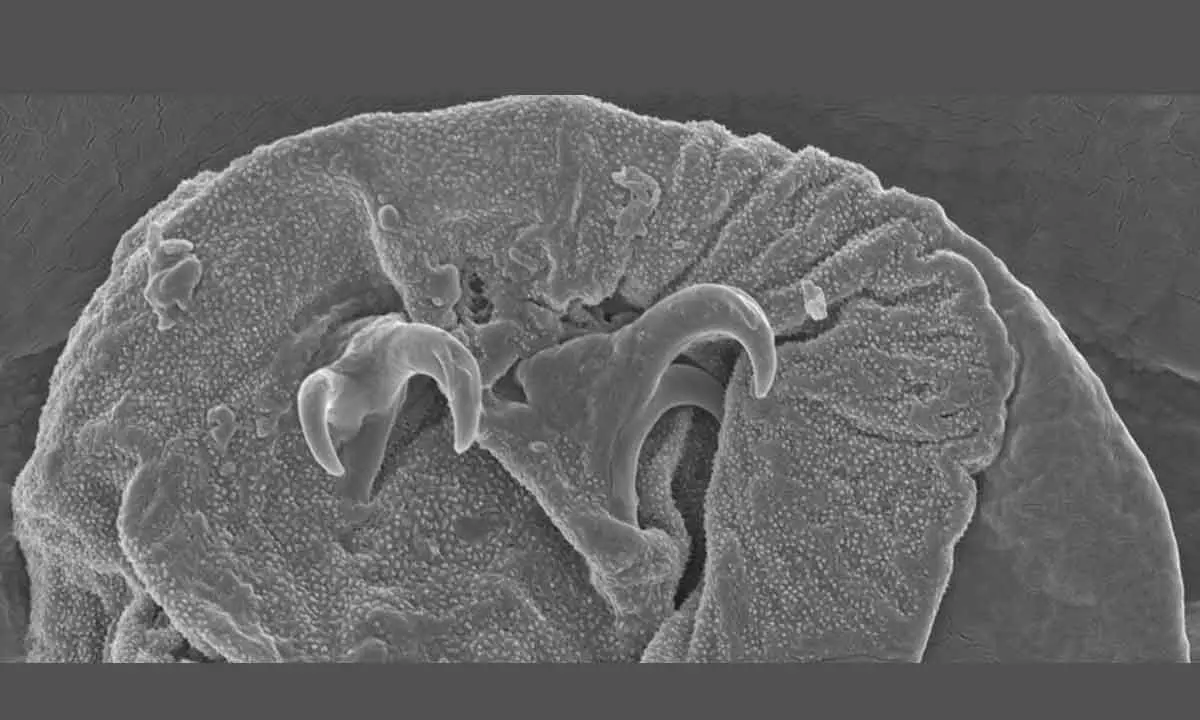Live
- Police arrest minor for stealing, 5 bikes recovered
- Veterinary students seek Chancellor’s intervention in securing stipend hike
- 2 arrested for duping 90 persons of `12 cr
- More than 13 lakh people applied for ration card
- Thief snatches woman’s chain inside home in Kukatpally
- Strict measures in Place for AP SSC examinations
- Kancha Gachibowli land: Activists launch campaign to preserve urban lung space
- GHMC proposes euthanasia for aggressive strays
- Over 6 lakh Olive Ridleys turn up at Gahirmatha
- Two women journos held for ‘defaming’ CM
Researchers Discovered A Brand-New Species Of Tardigrade


Macrobiotus naginae reveals its claws.
- Researchers have discovered a new species of tardigrade with sand dunes adaptations and provide new evidence that some tardigrades select places to colonise by riding inside snails in two investigations.
- The recently discovered tardigrade is from Rokua National Park in Finland's North Ostrobothnia region, where scientists discovered it subsisting in a dune woodland on lichen and moss.
Tardigrades are tiny, incredibly resilient creatures that can withstand a variety of threats, including many that would wipe out the majority of other known species. On the entire surface of the planet, from mountains to oceans to ice sheets, various tardigrade species have adapted to particular habitats. Inadvertent excursions outside of the safety of their natural habitats can lead to opportunities thanks to their adaptability.
Researchers have discovered a new species of tardigrade with sand dunes adaptations and provide new evidence that some tardigrades select places to colonise by riding inside snails in two investigations. The recently discovered tardigrade is from Rokua National Park in Finland's North Ostrobothnia region, where scientists discovered it subsisting in a dune woodland on lichen and moss.
Rokua's environment has been altered by wind and glaciers, creating eskers, kames, and kettle holes in addition to dunes. A lichen-rich inland dune woodland, a habitat that is in danger due to human activity, is also found there.
Macrobiotus naginae.
A group of researchers travelled to Rokua under the direction of University of Jyvaskyla biologist Matteo Vecchi to gather moss, lichen, leaf litter, and grass roots from the sand. They discovered a new species in addition to tardigrades. It joins the Macrobiotus pseudohufelandi complex, a small group of tardigrades with adaptations including smaller legs and claws for living underground, as just the fifth known member.
The researchers note that these tardigrades, like many subterranean creatures, may have developed smaller limbs for a more streamlined shape to crawl through sand or soil. While tardigrades in general require water, they also have the ability to endure prolonged dry spells, which may be useful in more desert regions.
During anhydrobiosis, tardigrades expel their body's water to transform into a dry, nearly unbreakable speck known as a tun. A tardigrade can live in this suspended state for years or even decades until rapidly reviving in the presence of water.
The tun state can shield tardigrades from a variety of other threats as well, including as high temperatures, low oxygen levels, oxygen deprivation, X-ray bombardment, gunfire, and space vacuum. This skill may aid tardigrades in surviving dry periods in their habitats or it may aid them in colonising new areas by guiding them through hostile terrain in the event that the wind sweeps them away.

© 2025 Hyderabad Media House Limited/The Hans India. All rights reserved. Powered by hocalwire.com






